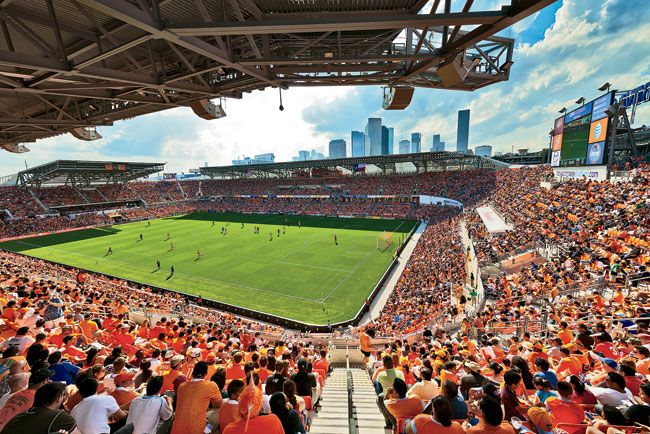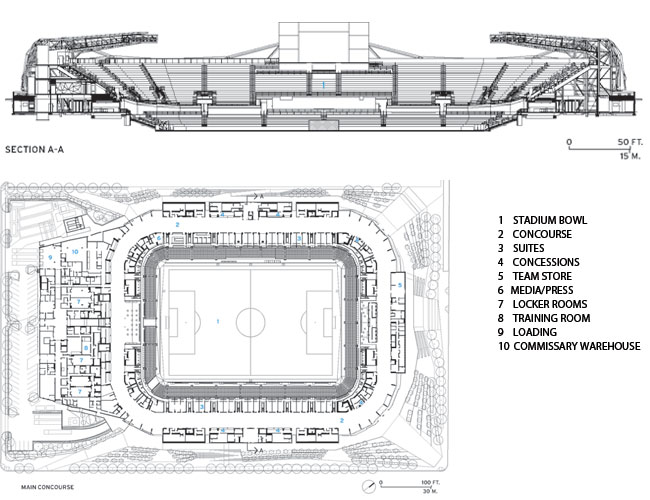BBVA Compass Stadium
Muscular Mesh: Populous’s new BBVA Compass Stadium for Houston’s soccer team vividly conveys energy and dash.










Architects & Firms
Houston, Texas
In a country fueled by a love for sports, it seems strange that only 23 years ago there were no soccer-specific stadiums in the U.S. As United States Soccer Federation spokesperson Neil Buethe puts it, “It's the most popular sport in the world everywhere but the U.S.,” and adds, “But now soccer is rapidly catching up to football, basketball, and baseball.” Buethe credits globalization and the support of investors with the growing adulation of the sport, noting that Major League Soccer stadiums in America currently total 12, with more on the boards or in the planning stages.
Joining the list of new venues is BBVA Compass Stadium, designed by Populous (formerly HOK Sport) as home for the Major League Soccer team the Houston Dynamo. With its unique metal-mesh facade and prominent location in downtown Houston's gentrifying East End district, the stadium stands out: The fans literally have a glowing (when lit at night) 22,000-seat destination from which to cheer on their team. “These guys have a huge fan base, and after years of sharing the University of Houston's stadium they finally had the chance to have a home of their own,” says Populous lead designer Jeff Spear.
The way the 343,500-square-foot stadium fits into the urban context is part of its appeal. Significantly, the stadium limited parking to 1,800 spots on the 12-acre site. It helps that a light-rail station is under construction across the street and additional cars can be stowed in nearby lots, including at Minute Maid Park, home of the Houston Astros baseball team. Visitors can easily walk from one stadium to the other and the convention center. As a phalanx of bars, restaurants, and galleries keeps expanding, the area should turn into a lively, busy part of the city.
The $65 million stadium also accommodates other sports—rugby, lacrosse, even boxing—as well as musical events on the 5,000-square-foot, 80-foot-wide-by-60-foot-deep stage. Located in the south end zone, it can be hidden during sporting events by demountable seats.
Yet the stadium's status as a soccer venue meant it required an intimate atmosphere—fans need to feel they're a part of the action. While a roof amplifies noise and helps increase the level of excitement for the games, BBVA Compass is open-air, with only canopies over 12,000 of its 22,000 seats. Nevertheless, the 75-by-115-foot, unheated Bermuda-grass pitch feels close from any seat on the lower level, as well as from the upper level's 33 suites, all located less than 10 rows from the playing field. In addition to the seating, the lower level provides locker rooms and assorted service areas.
For the design of the stadium, the team of architects and engineers used building-information modeling (BIM) to enable a highly collaborative effort, from schematic design through construction documentation. By working with one main model, updated weekly, the involved parties could get the stadium into construction quickly and have it finished in just 14 months—a boost for the team and its fans, who had been waiting through five years of city negotiations.
Bright orange now appears on seats and signage, as well as on polycarbonate-sheathed walls beneath the signature metal-mesh facade. Clad with 94,000 square feet of anodized-aluminum panels, which were machine-expanded to create a tessellated pattern, the steel armature is lit from below to turn the stadium into a glowing, circular urban beacon. If Herzog & de Meuron's 2008 Beijing National Stadium (aka the Bird's Nest) comes to mind, Spear offers a certain rationale: “We wanted the structure to reflect both the musculature of the players and the industrial history of the area.”
The apparent random shape of the building represents an efficient choreography, says Bart Miller of Walter P. Moore, the structural engineer for the project. Triangles form the facets of the skin, and the corners function as connecting nodes—so that every steel connection is exactly the same. The mesh allows air to flow freely through the stadium, but since it had to withstand hurricane-strength winds, the engineers gave the fabricators a deflection limit for load-testing different materials at various thicknesses.
Since the stadium opened in May, the games have sold out, and the Dynamo has had an undefeated home-game season so far. The architecture should get some credit.
Completion Date: May 2012
Gross square footage: 343,500
Total construction cost: $65 Million
PeopleOwner’s Representative/Project Manager: ICON Venue Group
Architect: Personnel in architect's firm who should receive special credit:
Architect of record: Populous Interior designer: Populous Graphic designer: Populous
Engineer(s): Civil Engineer: WGA MEP Engineers: ME Engineers
Life Safety Engineer: Howe Engineering Lighting: M-E Engineers Acoustical: WJHW Foodservice: Duray Playing Field: Millennium Sports Construction Manager: Manhattan Construction Photographer(s): Geoffrey Lyons Renderer(s): Populous CAD system, project management, or other software used: REVIT |
Products
Structural system
Exterior cladding Metal Panels: Crown Corr Inc.-AMICO Expanded Metal Mesh Precast concrete tilt wall: JLG Structures, Texcote exterior paint finish Precast concrete seating bowl: Heldenfels Enterprises Portable seating/stage platforms: StageRight Permanent grandstands: Dant-Clayton Curtain wall: YKK Structural Steel Paint Finish: PPG Amercoat
Roofing
Windows Folding Glass wall: Nana Wall
Glazing Insulated-panel or plastic glazing: Rob Pelletier Construction-DuoGard Industries, Inc, Amerilux Lexan Polycarbonate ThermoClick
Doors Metal doors: CECO Upswinging doors, other: Renlita Doors/ ABC Doors
Hardware Closers: LCN Exit devices: Von Duprin Pulls: Ives Security devices: ADT Other special hardware: Zero International
Interior finishes Suspension grid: Applied Finish Systems- USG Cabinetwork and custom woodwork: Buda Woodwork Paints and stains: Ideal Finishes-Devoe, Glidden, Scuffmaster Plastic laminate: Formica, LaminArt, Wilson Art Solid surfacing: Corian Floor and wall tile: Dal-Tile Resilient flooring: Quality Service Floor Covering-Armstrong Carpet: Quality Service Floor Covering-Atlas, Lees, Durkan/Mohawk Group
Furnishings Reception furniture: Sit On It Seating Fixed stadium seating: SEDA Sport Seating Chairs: One Furniture Group Tables: One Furniture Group
Lighting Exterior: Melton Electric Dimming System or other lighting controls: Johnson Controls
Conveyance
Plumbing Energy Energy management or building automation system: Johnson Controls |






